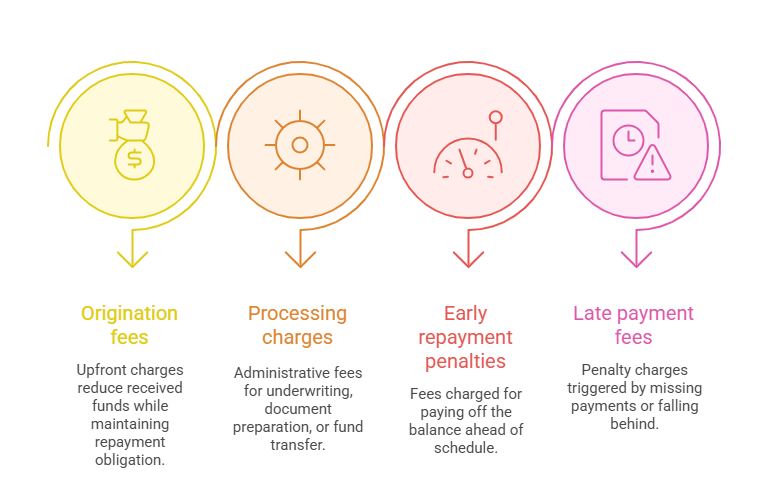How to Calculate True Cost of Funding for Your Business
Understanding how to calculate true cost of funding can mean the difference between smart financial decisions and costly mistakes. When you're exploring financing options, the numbers might seem straightforward at first glance, but there's often more beneath the surface. Different funding products use various rate structures, fee schedules, and repayment terms that can significantly impact your total cost.
Many business owners focus solely on the advertised rate without considering the full picture. However, the true cost involves multiple factors including the type of rate being used, hidden fees, and how quickly you'll repay the advance. By mastering these calculations, you'll be equipped to compare funding options accurately and choose the best fit for your business's cash flow and growth plans.
Understanding Factor Rate Fundamentals
Understanding factor rate fundamentals is crucial when learning how to calculate the true cost of your funding. Factor rates work differently from traditional interest rates, and this distinction affects your total repayment amount significantly.
- Simple multiplication approach: Factor rates typically range from 1.1 to 1.5, and you multiply your advance amount by this rate to determine total repayment
- Fixed total cost: Unlike traditional interest that compounds over time, factor rates create a fixed repayment amount regardless of how quickly you pay
- No compounding effect: The total cost remains constant whether you repay in three months or twelve months
- Straightforward calculation: If you receive a $50,000 advance with a 1.3 factor rate, you'll repay exactly $65,000 total
Key Differences Between Factor Rate vs APR
The factor rate vs APR comparison reveals fundamental differences that impact how you should evaluate funding costs. These rate types serve different purposes and provide varying insights into your financing expenses.
- Time consideration: APR accounts for the time factor and represents an annualized cost, while factor rates ignore repayment timeline
- Fee inclusion: APR typically includes additional fees in its calculation, providing a more comprehensive cost view
- Repayment speed impact: Faster repayment with factor rates may result in higher implied APR but doesn't change the total dollar cost
- Comparison utility: APR allows easier comparison between different funding products, while factor rates show exact dollar costs upfront
Hidden Costs in Fee Structure Clarity

Achieving fee structure clarity requires examining all potential costs beyond the advertised rate. Many funding products include additional charges that can substantially increase your total expense if overlooked.
- Origination fees: These upfront charges might reduce the actual funds you receive while maintaining the same repayment obligation
- Processing charges: Administrative fees for underwriting, document preparation, or fund transfer can add unexpected costs
- Early repayment penalties: Some funding products charge fees if you pay off the balance ahead of schedule
- Late payment fees: Missing payments or falling behind on daily/weekly remittances typically triggers penalty charges
Essential Fee Categories to Monitor
Essential fee categories require careful attention when calculating your true funding cost. These charges often appear in the fine print but can significantly impact your bottom line.
- Maintenance fees: Monthly or quarterly charges for account management and ongoing service
- ACH processing costs: Fees for automatic bank transfers during the repayment period
- Documentation fees: Charges for legal document preparation, filing, or notarization requirements
- Third-party costs: Expenses for credit checks, bank verification, or other external services passed to you
Building Accurate Repayment Modeling Systems

Building accurate repayment modeling systems helps you predict cash flow impacts and plan accordingly. Effective models consider your business's revenue patterns and seasonal fluctuations.
- Analyze historical sales data: Review past revenue patterns to understand your typical cash flow cycles and identify peak and slow periods
- Factor in seasonal variations: Account for times when revenue might dip or spike, affecting your ability to meet repayment obligations
- Calculate daily payment impacts: Determine how daily or weekly payments will affect your available working capital
- Create contingency scenarios: Model what happens if revenue drops by 10%, 20%, or 30% to ensure repayment remains manageable
- Test different funding amounts: Compare how various advance sizes would impact your cash flow to find the optimal balance
Strategic Financial Planning Integration Methods
Strategic financial planning integration methods ensure your funding decisions align with broader business objectives. Proper integration helps you use financing as a growth tool rather than just a cash flow solution.
- Set clear funding objectives: Define whether you need financing for inventory, equipment, marketing, or operational expenses before comparing options
- Align repayment with revenue cycles: Match your payment schedule with when you expect the funded activities to generate returns
- Build growth projections: Calculate how the funding will impact revenue growth and whether increased income justifies the cost
- Plan for multiple funding rounds: Consider how current financing affects your ability to secure future funding when needed
- Monitor key performance metrics: Track ROI, cash flow ratios, and debt service coverage to measure funding effectiveness
Making Informed Funding Decisions
Making informed funding decisions requires combining all cost calculations with your business's specific needs and circumstances. The lowest cost option isn't always the best choice if it doesn't match your cash flow patterns or growth timeline. Consider how quickly you need funds, your repayment capacity, and whether the financing structure supports your business model. Remember that understanding the true cost empowers you to negotiate better terms and choose funding that truly serves your business's success.
Mastering how to calculate true cost of funding puts you in control of your business's financial future. By understanding factor rates, decoding fee structures, and building accurate repayment models, you can make confident decisions that support growth while protecting cash flow. Remember that the cheapest option on paper might not always be the best fit for your specific situation. Take time to run the numbers, consider your business cycles, and choose funding that aligns with your strategic goals. With these tools in hand, you're ready to navigate the funding landscape like a seasoned pro.

.png)






